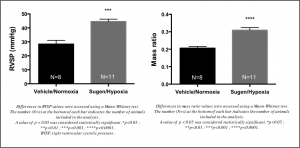Pulmonary arterial hypertension (PAH) is a syndrome in which pulmonary arterial obstruction increases pulmonary vascular resistance, leading to right ventricular hypertrophy (RVH), failure, and death. The development of small-animal preclinical models of PAH is a necessary challenge in order to test the efficacy of new drug candidates. Since mice have the advantage of being genetically modifiable, Syncrosome has set up and validated a preclinical PAH mouse model combining the vascular endothelial growth factor receptor antagonist (Sugen) and the exposure to chronic hypoxia.Our new model presents reproducible PAH conditions, with elevated right ventricular systolic pressure (RVSP) and RVH compared to control mice (Figure).This new mouse model makes it possible to carry out preclinical efficacy studies on PAH by the use of genetically modified mice or gene therapy.

Figure : RVSP and mass ratio (right ventricle/left ventricle + septum) differences between Sugen/hypoxia and Vehicle/Normoxia mice.
On the other hand, since several years, Syncrosome propose three different preclinical rat models of PAH (chronic hypoxia exposure, monocrotaline-induced and Sugen/hypoxia-induced models). Our rat and mouse preclinical models of PAH allow drug discovery companies to perform preclinical efficacy studies according to their needs.
A few words about Syncrosome:
Syncrosome is an Efficacy Characterization CRO offering relevant disease models, cutting-edge techniques and a comprehensive background of physiopathology to assist drug discovery companies.We have developed and validated so far more than 15 disease models, and our flexible and human-sized organization can design and operate tailored experimental protocols to give you appropriate answers. Our main activities include :
- Drug Efficacy Studies in several therapeutic areas :
- Central Nervous Sytem,
- Cardiovascular and Metabolic diseases,
- Respiratory System,
- Early bioavailability and CNS-PK on rodents and non-rodents, with a high competence in the study of the Blood Brain Barrier passage.


